SOCIAL WORK
Paper – II
Note : This paper contains fifty (50) objective type questions of two (2) marks each. All questions are compulsory.
1. Practice wisdom denotes :
(1) Skills based on personal experiences of other social workers.
(2) Skills based on personal experiences in research.
(3) Skills based on personal experience in practice.
(4) Skills based on common sense.
2. ‘Active Listening’ concept was developed by
(1) Carl Rogers
(2) William Reid
(3) Sigmund Freud
(4) John Bowlby
3. Which one of the following cannot be dealt by social work as
(1) Conscious
(2) Pre-conscious
(3) Sub-conscious
(4) Unconscious
4. Square root of the average of squares of deviations, when such deviations for the individual items in a series are obtained from arithmetic average is known as :
(1) Mean deviation
(2) Standard deviation
(3) Range
(4) Skewness
5. Those who tend to be solitary, insensitive and uncaring about others are high on :
(1) Assertiveness
(2) Agreeableness
(3) Manipulation
(4) Psychoticism
6. Culture is
(1) Genetically transmitted
(2) Socially transmitted
(3) Politically transmitted
(4) Genetically and Politically transmitted
7. Peer group is a group whose members share
(1) similar playground
(2) similar circumstances
(3) similar study circle and books
(4) similar values
8. Which of the following community approaches was not given by M.G. Ross ?
(1) The specific content approach
(2) The general content approach
(3) The process approach
(4) The social planning approach
9. Which one of the following is not correctly matched ?
(1) M.G. Ross – Community
(2) P.D. Kulkarni – Social Policy in India
(3) H.B. Trecker – Social Group Work
(4) M.S. Gore – Social Case Work
10. “Functional approach” in social case work was developed by
(1) Jessie Teft
(2) Otto Rank
(3) Gordon Hamilton
(4) Talcott Parsons
11. Who among the following is/are best associated with models – social goals, remedial and reciprocal – of social group work ?
(1) G. Konopka
(2) Toseland & Rivas
(3) Papell and Rothman
(4) Glasser and Mayada
12. Behaviour modification involves
(1) solving problems through insight
(2) bringing behaviour under stimulus control
(3) demonstrating learning in the absence of reinforcement
(4) application of learning principles to change behaviour
13. Generally the responsibility for the choice of programme in group work rests with _____.
(1) Members of the group
(2) Group worker
(3) The agency
(4) Members, agency and the worker
14. Which among the following are the prime focuses of ‘Sustainable Development Goals’ ?
(1) Peace and Prosperity
(2) People, Planet and Prosperity
(3) People, Partnership and Peace
(4) People, Planet, Prosperity, Peace and Partnership
15. “A comprehensive concept which implies major structural changes which are introduced as part of deliberate action to transform a society” is called as
(1) Social change
(2) Social development
(3) Community development
(4) Social action
16. The formula ![]() is used to calculate _______.
is used to calculate _______.
(1) General Fertility Rate (GFR)
(2) Gross Reproduction Rate (GRR)
(3) Specific Fertility Rate (SFR)
(4) Crude Birth Rate (CBR)
17. Which among the following is/are not a characteristic features of a good leader ?
i. authoritarian approach.
ii. distribution of responsibility
iii. rapport with individual members
iv. understanding group dynamics.
Codes :
(1) i only
(2) i and iv only
(3) ii and iii only
(4) iv only
18. Which among the following titles of the Acts are wrongly mentioned ?
i. Child Labour Protection Act
ii. Employees’ Family Provident Fund Act
iii. Bonded Labour Rehabilitation Act
iv. Employees’ State Insurance Act.
Codes :
(1) i and ii only
(2) ii and iii only
(3) iii and iv only
(4) i, ii and iii only
19. Which among the following statements is /are true in case of ‘violence against women’ ?
i. There is no specific section in the IPC to deal specifically with acid attacks.
ii. Honour killing is a death awarded to a woman or girl for marrying against the wishes of her parents.
iii. Women are generally abused and attacked by men they know.
iv. The most important motives of abduction of women are sex and marriage.
Codes :
(1) i, ii and iii only
(2) i, ii, iii and iv
(3) ii, iii and iv only
(4) iii and iv only
20. From the following stages of psychological development propounded by Erikson, find the correct answer :
I. Play age – Initiative v/s guilt
II. School age – industry v/s inferiority
III. Adolescence – Autonomy v/s shame and doubt
IV. Young adulthood – Intimacy v/s isolation
Codes :
(1) I and II
(2) II and III
(3) III and IV
(4) I, II and IV
21. A stress situation which approaches or exceeds adaptive capacities of an individual or a group is called
(1) Catharsis
(2) Crisis
(3) Acute stress
(4) Chronic stress
22. Who among the following is best associated with ‘Gestalt therapy’ ?
(1) C.R. Rogers
(2) Sigmund Freud
(3) B.F. Skinner
(4) Fritz Perls
23. The Persons with Disability (Equal Opportunities, Protection of Rights and Full Participation) Act assented by the President of India on 1st January
(1) 1993
(2) 1994
(3) 1995
(4) 1996
24. The responses to events that are threatening or challenging is called
(1) Depression
(2) Stress
(3) Emotion
(4) Negative feeling
25. _____ is a graphic representation of the choices or the association of group members using symbols for people and their interactions.
(1) Histogram
(2) Sociogram
(3) Sonogram
(4) Isogram
26. While testing Hypothesis, the following types of error may creep-in. Identify the correct one :
(1) Type I Error – Rejection of a null hypothesis when it is true and when it should not have been rejected.
(2) Type I Error – Acceptance of a null hypothesis when it is false.
(3) Type II Error – Acceptance of null hypothesis when it is true.
(4) Type II Error – Rejection of null hypothesis when it is false.
27. Who among the following is best associated with ‘Rapid Rural Appraisal’ (RRA) ?
(1) Britto G.A.A.
(2) Robert Chambers
(3) Fried Lander
(4) Luigi Cavestro
28. The advantages of Thurstone scale is
(1) The statements are precisely mentioned.
(2) The judges decide the importance of each statement.
(3) The statements are easy to prepare.
(4) All statements are considered to be of equal in weightage.
29. Claiming authorship for the material / findings / work that is not owned by the person and by not acknowledging the work of others is referred to as
(1) Plagiarism
(2) Duplication
(3) Repetition
(4) Copying
30. Identify the correct name :
(1) The Narcotic Drugs and Psychotic Substances Act
(2) The Narcotic Drugs and Psychic Substances Act
(3) The Psychotropic Drugs and Narcotic Substances Act
(4) The Narcotic Drugs and Psychotropic Substances Act
31. Which one of these is not a criteria of man – power planning ?
(1) Employee turnover
(2) Rate of growth of organisation
(3) Future man – power needs
(4) Job enrichment
32. Job specification is related to
(1) Work description
(2) Analysis of work
(3) Prospect of work
(4) Qualification and experience
33. Which article of Indian Constitution considers the claims of Scheduled Castes and Tribes in the working of appointments to services and posts in connection with the affairs of the Union or of a State ?
(1) Article 330 (2)
(2) Article 164 (1)
(3) Article 335
(4) Article 16
34. Which is not dimension of Human Resource Development ?
(1) Performance Appraisal
(2) Career Development and Planning
(3) Recruitment
(4) Training
35. Match the following List-I with List-II :
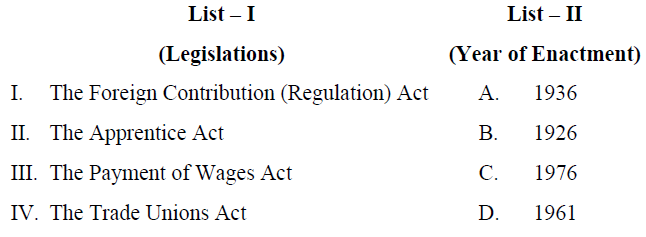
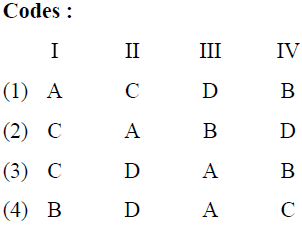
36. Match the items in List-I with List-II :

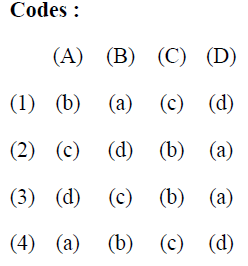
37. Match List-I with List-II and choose the correct answer from the codes given :

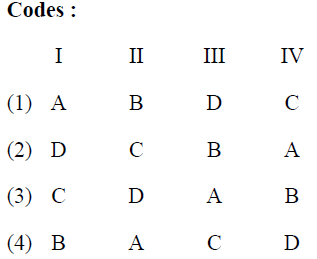
38. Match the List-I with List-II and choose the correct answer from the codes given :
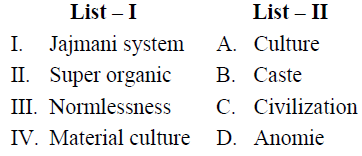
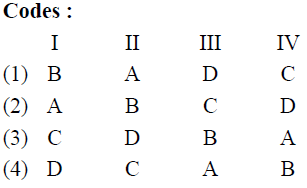
39. Match List-I with List-II and choose the correct answer from the codes given :

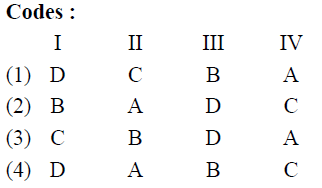
40. Match List-I with List-II and select the correct answer from the codes given below :

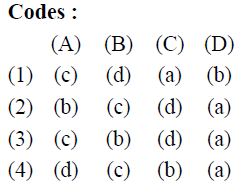
41. Assertion (A) : Effective field work training is only possible with integration of theory and practice.
Reason (R) : Social work is a practicing profession.
Codes :
(1) Both (A) and (R) are correct, but (R) is not the correct explanation of (A).
(2) (A) is correct and (R) is wrong.
(3) Both (A) and (R) are correct and (R) is correct explanation of (A).
(4) (A) is wrong and (R) is correct.
42. Assertion (A) : Social work has not been able to establish its identity in India.
Reason (R) : Social work practice is broad based.
Codes :
(1) (A) is correct and (R) is wrong.
(2) (A) is wrong and (R) is correct.
(3) Both (A) and (R) are correct and (R) is correct explanation of (A).
(4) Both (A) and (R) are correct and (R) is not the correct explanation of (A).
43. Assertion (A) : Social work promotes social justice.
Reason (R) : Social work gives equal opportunity to all to develop their personality in the way they like and approved by the society.
Codes :
(1) (A) is true, but (R) is false.
(2) (A) is false, but (R) is true.
(3) Both (A) and (R) are true and (R) is correct explanation of (A).
(4) Both (A) and (R) are correct, and (R) is not the correct explanation of (A).
44. Arrange in sequence the structure of a funding proposal.
(1) Background, statement of the problem, justification of the project, goals and objectives, planned activities, division of responsibilities, implementation.
(2) Background, justification of the project, statement of the problem, goals andobjectives, division of responsibilities, planned activities, implementation.
(3) Background, statement of the problem, goals and objectives, justification of the project, division of responsibilities, planned activities, implementation.
(4) Background, justification of the project, statement of the problem, goals and objectives, division of responsibilities, planned activities, implementation.
45. Arrange in an order of sequence the following phases in female victim’s adjustment to life after stigmatization.
i. removing pain
ii. avoidance and humiliation
iii. shock and pain
iv. adaptation
Codes :
(1) i, iii, iv, ii
(2) iii, i, ii, iv
(3) ii, iv, iii, i
(4) iv, ii, i, iii
Read the passage given below and answer the following questions (46 – 50) as per the understanding of the passage :
Cultural competence is the capacity to work effectively with people from a variety of ethnic, cultural, political, economic and religious backgrounds. It is being aware and respectful of the values, beliefs, traditions, customs, and parenting styles of those we serve, while understanding that there is often as wide a range of differences within groups. Cultural competency is about developing skills. This includes improving your ability to control or change your own false beliefs, assumptions and stereotypes; to think flexibly; to find sources of information about those who are different from you; and to recognize that your own thinking is not the only way.
Cultural competence allows social workers to feel comfortable and be effective in their interactions with families whose cultures are different from their own. It enables families to feel good about their interactions with their social worker, and it allows the two parties to accomplish their goals.
Cultural competence requires an open mind and heart and the willingness to accept the views of others. It may mean setting aside your own beliefs in order to better serve others. Generally, we need to lower our defences, take risks, and practice behaviours that may be uncomfortable or unfamiliar. Remember that all people are alike in some ways and different in others. Everyone needs to eat, have clothes and shelter, to learn, to grow, and to experience
meaning and purpose in their lives.
The first step toward being more culturally competent is self-awareness. To understand and appreciate the culture of others, we must first understand and appreciate our own culture. There are several ways to learn about other cultures. First, find someone – a friend, neighbour, or colleague – who can serve as your “guide” to the culture. You can also study a culture by reading history, geography, poetry, biography, and fiction. In addition to reading or using a guide, you can participate in the daily routine of the culture you wish to learn about by celebrating their holidays, working on community projects, and attending worship. Finally, you can learn the language.
46. What is the relevance of cultural competence in social work practice ?
(1) It helps social work practitioner to be more vigilant about the bad elements in the society.
(2) It allows social workers to feel comfortable and be effective in their interaction with families whose cultures are different from their own.
(3) It enables the social workers to be familiar with their own culture.
(4) It is not at all relevant for social work practice.
47. What do you understand by cultural competence ?
(1) To test the competence of any culture.
(2) To know how important is a culture in a given society.
(3) It is the capacity to work effectively with people from a variety of ethnic, cultural, political, economic and religious backgrounds.
(4) It is to test the validity of values and norms of a community for its proper functioning.
48. What qualities are required in social workers to learn cultural competence ?
(1) It requires an open mind and heart and the willingness to accept the views of others.
(2) It requires great determination and will power.
(3) Social worker must be dedicated to their work.
(4) It requires theoretical knowledge about cultures of the clients.
49. Is cultural competency a skill in social work ?
(1) No, it is not a skill.
(2) It depends on the interest of the social worker.
(3) It is for improving social worker’s ability to be flexible about others.
(4) It is a working style of a social worker.
50. How do we learn the culture of others ?
(1) It can be learned by experience.
(2) It is very difficult to learn.
(3) It can be learned through a friend, neighbour or a colleague who can serve as your guide to the culture.
(4) Classes in an academic institution.
Latest Govt Job & Exam Updates: